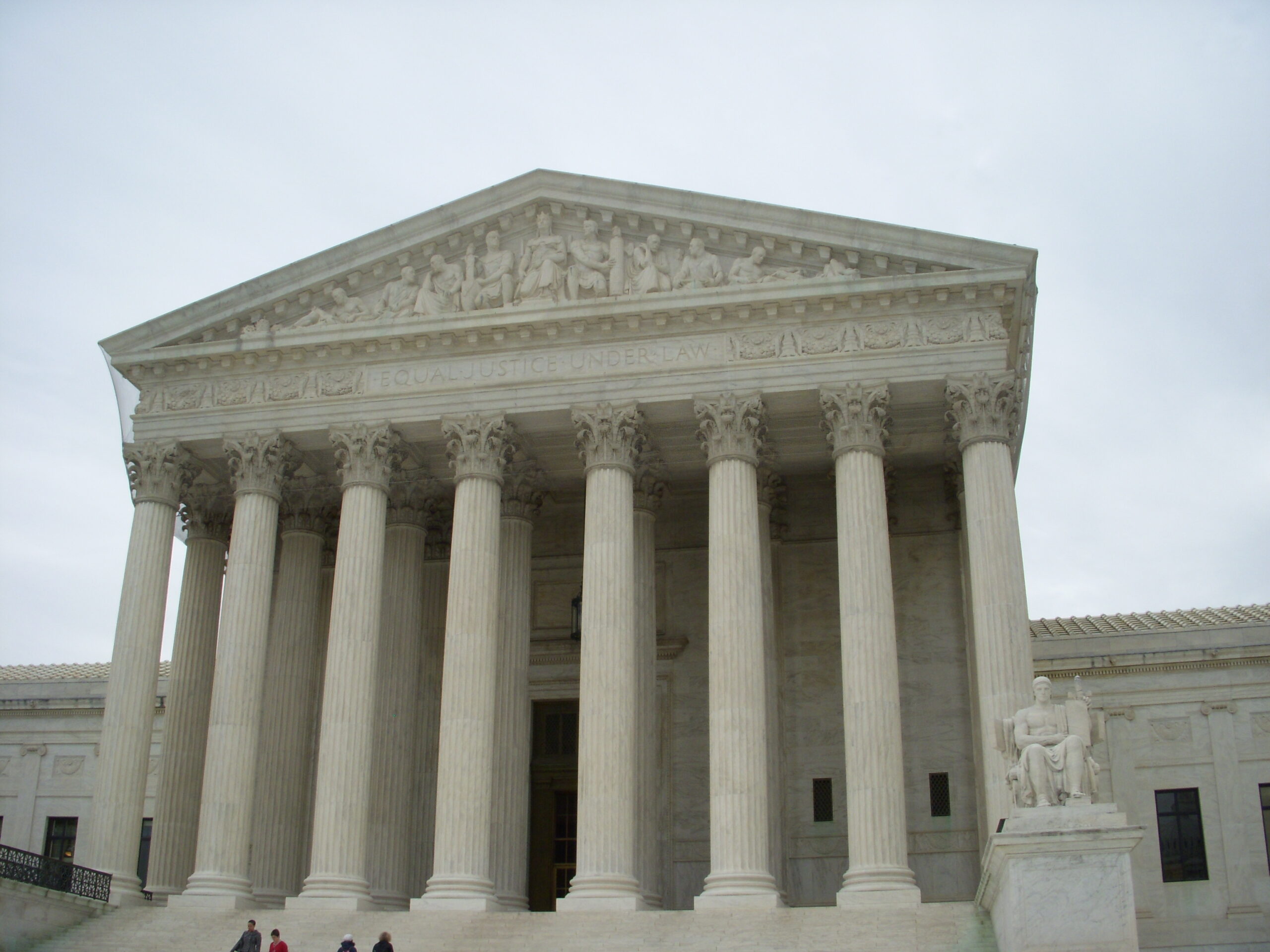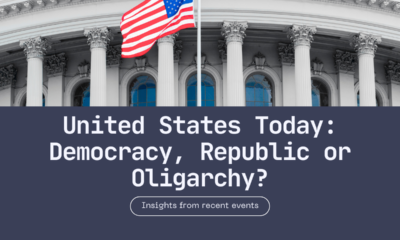Constitution
The Case That Should Restore Our Government
The case of Jarkesy v. SEC could end the unconstitutional rule of Administrative Law Judges and return adjudication to the courts.

Noah Rosenblum’s Atlantic piece on Jarkesy v. SEC, a case that was argued at the Supreme Court Wednesday, is alarmingly titled “The Case That Could Destroy Our Government.” This apocalyptic take is the culmination of a concerted effort on the part of sectors of the legal media and academia to hoodwink the American public about a case that simply seeks to restore adjudication of government prosecutions to courts – where the Constitution solely placed the judicial power – as well as fulfilling the Constitution’s promise of a jury trial which Congress cannot take away. Rosenblum’s alarmist essay demands a detailed rebuttal.
What the Case Is Really About
George Jarkesy was charged in 2013 in a civil action alleging securities fraud which had historically been brought by the Securities and Exchange Commission in federal district courts before real judges. The 2010 Dodd-Frank legislation sought to change that by allowing the SEC to charge Mr. Jarkesy in the SEC’s own in-house administrative adjudications, where the judge is essentially employed by the prosecutor. Such SEC proceedings had originally been set up to determine relatively minor licensing and other regulatory requirements.
Consider what this means for Americans. The SEC makes rules, formally and informally, and through enforcement proceedings announces new rules, often retroactively. It has unchecked power to launch investigations that can last years and which lead to a recommendation to itself to commence an in-house prosecution which the commission, unsurprisingly, approves. But since 2010, the same enforcement team that investigates and recommends prosecution becomes the prosecutor before an administrative law judge (ALJ) employed by the very commission that launched the investigation and approved the prosecution in the first place.
If the ALJ rules against defendants such as Jarkesy, as ALJs do nearly 100% of the time, his first avenue of appeal is to … the commission. If the ALJ rules for Jarkesy, which virtually never happens, the commission can appeal to … the commission – the entity that voted to prosecute him in the first place. Once found liable, only then can a person in Jarkesy’s situation seek redress in a federal court of appeals which by law indulges in a heavy presumption that the administrative adjudication is correct on matters of fact and of law.
What makes Jarkesy’s case particularly compelling is that in 2014, he sought access to real, unbiased courts for his prosecution. He was denied jurisdiction to bring his jury trial and other challenges to a federal court by a D.C. Circuit Court panel that included Brett Kavanaugh. Six other circuits followed this precedent. But earlier this year, in April 2023, the Supreme Court unanimously overruled that 2014 decision in Axon v. FTC; Cochran v. SEC, denying him access to a real federal court, overruling all six circuits that had so erred.
But before that decision was handed down, Jarkesy had already been stuck in the morass of this faux justice where the ALJ, affirmed by the commission, ordered him to pay $300,000 in fines and barred him for life from the industry. Only then, after seven long years, did the Fifth Circuit Court of Appeals finally hear his constitutional claims for the first time. It held in 2022 that he had been denied his jury trial right, that his ALJ was too insulated from presidential control and thus unconstitutional, and that Congress could not vest the decision of whether he gets a court trial in the SEC’s unfettered discretion.
While that appeal was pending, in April 2022, the SEC disclosed that SEC enforcement staff were found to have improperly accessed privileged files of the ALJs in his and dozens of other administrative proceedings. The SEC has steadfastly refused to comply with FOIA laws regarding these breaches, going so far as to dismiss all 42 of its open administrative proceedings to avoid disclosure of the extent of these breaches, and worse, to strategically manipulate court dockets so that no other open proceeding can bring challenges like Jarkesy’s or to shed light on the misconduct.
You hear nothing about Mr. Jarkesy’s Kafkaesque journey in the Atlantic article or the litany of other mainstream reporting on the case. The SEC’s widespread misconduct, which went on for years across dozens of already structurally biased proceedings, goes unmentioned. Scholars like Rosenblum ignore these uncomfortable facts.
Ignoring this long journey by George Jarkesy to vindication in court, Rosenblum concocts a charge that the case “terrifyingly” threatens all government regulation, “destroying the federal government’s administrative capacity – taking down its ability to protect Americans’ health and safety while unleashing fraud in the financial markets.”
He describes Jarkesy’s Sisyphean attempt to secure a constitutional adjudication of his claims as “chutzpah.” He describes the opinion below as “all but ruling the SEC’s entire existence is unconstitutional.” (This is nonsense. Agency adjudication is only a small part of what the SEC does and for most of its existence it has had to bring claims in federal court where defendants have jury trial and due process rights.)
“Wild stuff,” he calls these claims. “A lawyer would have been laughed out of court for [bringing these] claims.” He as much as calls George Jarkesy a crook when no competent court of law has found him guilty of anything.
This bombast fails to illuminate the important issues affecting Americans’ constitutional rights and civil liberties – Removal Protections, Delegation of Legislative Power, and the Right to a Jury Trial. Addressing those in turn:
Removal Protections Don’t Work To Create Independence
Rosenblum makes a fair point when he writes that protections from removal of administrative “internal adjudicators” were understood “to provide for independence of in-house adjudicators.” True enough, as intentions go.
The short answer to this point is that the “independence” of multiple layers of tenure protection for ALJs has proven illusory. ALJs are structurally biased, which is in some ways worse than personal bias because such systemic bias infects all cases. ALJs are chosen and employed by the very agency prosecuting the defendant and they are dependent on the agency for promotions, salary increases, and benefits. As Justice Neil Gorsuch noted in Axon/Cochran, the nearly 90-100% win rate for the agency in front of ALJs as opposed to a 60-70% win rate when they are in a real federal court speaks volumes:
“The numbers reveal just how tilted this game is. From 2010 to 2015, the SEC won 90% of its contested in-house proceedings compared to 69% of the cases it brought in federal court,” Gorsuch wrote. “Meanwhile, some say the FTC has not lost an in-house proceeding in 25 years.”
Even aside from the ALJs themselves, the ALJ agency adjudication process is biased. It lacks the protections of the Federal Rules of Civil Procedure and Evidence; limits discovery, allows hearsay; and imposes deadlines that curtail the defendants’ time to prepare a defense. By contrast, the government agency benefits from years of investigation, agency-favoring deadlines and extensions, and a process so protracted and punitive that 98% of agency-charged defendants settle. Defendants simply cannot outlast or outspend this powerful government agency. As George Will recently pointed out in the Washington Post, “Many targets of SEC enforcement quickly settle cases that the SEC assigns not to a regular court with a neutral judge but to its in-house tribunals. This practice is analogous to prosecutors overcharging defendants to coerce them into plea bargains, vitiating their right to jury trials.”
Non-Delegation
The SEC has the choice of prosecuting defendants in district court – where defendants have the full range of constitutional protections including jury trial – or trying defendants before its own ALJs where a host of constitutional and procedural protections are unavailable. By leaving this choice in the prosecuting agency’s discretion, Jarkesy argues Congress has unconstitutionally delegated a question that Congress itself must decide (or must, at the very least, provide the agency with intelligible principles upon which to make this decision). Otherwise, some defendants get the full array of constitutional rights, while the unlucky others (like George Jarkesy) get none of them. This means that defendants who have engaged in identical conduct can be afforded different constitutional and procedural protections because the government unilaterally chooses what brand of justice you get. Congress cannot just give the SEC a blank check to pick winners and losers in the lottery of constitutional rights. Especially when the commission itself can elect to have a jury trial whenever it desires that right for itself. This unilateral power of the SEC to decide the quality of justice its targets will be afforded seemed to trouble some of the justices at argument.
Constitutional Guarantee to a Jury Trial
Most tellingly of all, Rosenblum never mentions the right to a jury trial. Not once. Yet it is the first question certified by the Supreme Court and the question that almost exclusively occupied the court at argument.
Juries are an important equalizer of the power inequities between the government and the governed. Many criminal justice reform advocates have highlighted the dangers of overly aggressive and coercive prosecution in the criminal context.
The dangers are equally present in the civil enforcement context. Just ask Mark Cuban, Nelson Obus, and others who filed an eloquent amicus brief on the critical difference a right to a jury made to them. As Mark Steinberg pointed out in the Harvard Law School Forumon Corp. Governance, “From the outset to its conclusion, the SEC’s case against Cuban was not impressive.”
A jury was able to see how weak the SEC enforcement case was and unanimously found Cuban not guilty. It discerned what the enforcement staff did not in its years-long relentless pursuit of Cuban – the SEC did not have much of a case. In the case of Nelson Obus, it took 12 years and $12 million to secure a unanimous jury verdict in his favor.
All Jarkesy wants is a fair shake and a jury trial, something all Americans were guaranteed at the founding and as recently as 2010. What is so threatening about a jury? Or fair proceedings before an unbiased, uncompromised judge?
Law schools used to stress that one should study the record of a case thoroughly before venturing to render an opinion about its significance. Has the legal professoriate and legal media lost sight of this basic principle?
This article was originally published by RealClearPolitics and made available via RealClearWire.
Peggy Little, Senior Counsel, comes to NCLA with over three decades of experience as a trial and appellate litigator in complex, high-stakes regulatory, mass-tort, class-action, products liability, securities, commercial and civil rights litigation representing individuals and high-profile litigants including Fortune 50 companies, financial institutions, public companies, and universities in state and federal courts, including the United States Supreme Court.
-

 Executive4 days ago
Executive4 days agoSecret Service chief gets no solace
-

 Executive3 days ago
Executive3 days agoWaste of the Day: Louisville Taxpayers Pay Nearly $600,000 For Empty Building’s Maintenance, Security
-

 Guest Columns5 days ago
Guest Columns5 days agoFear Itself: Democrats’ Favorite Strategy Caused Their Current Chaos
-

 Executive3 days ago
Executive3 days agoWhere is Joe Biden – or Jill?
-

 Executive2 days ago
Executive2 days agoWaste of the Day: Throwback Thursday: Cities Used Crime Prevention Funds on Soccer Games, Paper Shredding
-

 Executive2 days ago
Executive2 days agoFacile and politically motivated suggestions
-

 Civilization5 days ago
Civilization5 days agoBuild Iron Dome in the United States To Prepare for Israel’s Worst Day
-

 Executive2 days ago
Executive2 days agoBiden makes farewell whisper












